Grosella, Otaheite gooseberry
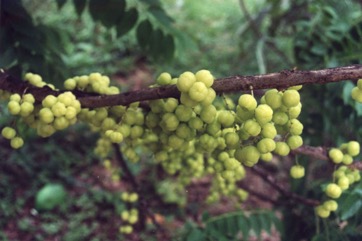
They are a tropical plant. It can grow in the hot humid tropical lowlands. They suit areas with a seasonal dry period. In Nepal it grows up to 250 m altitude. They are widely distributed near towns and sometimes cultivated for the edible fruit. It can grow in arid places. It suits hardiness zones 11-12.
Also known as:
Amla, Arinelli, Aura, Bai mak nyom, Bangkiling, Ceremoi, Cermai, Chalmeri, Chermai, Chum ruot, Goambili, Gooseberry Tree, Groselha, Grosella, Grosellero, Harfaruri, Harphareuri, Holpholi, Hor bori, Iba, Indian gooseberry, Kantuet, Kanturk srok, Kawl-sun-hlu, Lewathai, Ma yom, Mak-hkam-sang-paw, Mak nkom, Mak nyom, Malay apple, Malay gooseberry, Manzana lora, Mayom, Nelli, Nellipuli, Orbori, Orboroi, Peras, Pom lokhi, Pora amlokhi, Star gooseberry, Takeri thelu, Takiri thelu, Thinbaw-zibyu
Synonyms
- Averrhoa acida L.
- Cicca acida (Linn.) Merr.
- Cicca acidissima Blanco
- Cicca disticha L.
- Cicca nodiflora Lam.
- Phyllanthus acidissimus (Blanco) Muell.Arg.
- Phyllanthus cicca Muell. Arg.
- Phyllanthus distichus (L.) Mull. Arg.
Edible Portion
- Fruit, Leaves, Vegetable
Where does Grosella grow?
Found in: Africa, Asia, Australia, Bahamas, Bangladesh, Belize, Brazil, Cambodia, Caribbean, Central America, China, Colombia, Cook Islands, Cuba, Dominica, Dominican Republic, East Africa, El Salvador, Ghana, Guam, Guatemala, Guiana, Guianas, Guinea-Bissau, Guyana, Haiti, Hawaii, Himalayas, India, Indochina, Indonesia, Jamaica, Laos, Madagascar, Malaysia, Maldives, Mariana Islands, Marquesas, Mexico, Mozambique, Myanmar, Nepal, Nicaragua, Nigeria, North America, Northeastern India, Pacific, Pakistan, Philippines, Puerto Rico, SE Asia, Senegal, Seychelles, Singapore, South America, Sri Lanka, Suriname, Taiwan, Tanzania, Thailand, Timor-Leste, Tuvalu, Uganda, United States, Vietnam, West Africa, West Indies
Notes: There are about 600-800 Phyllanthus species. They are mostly in the tropics. Fruit are very acid. There are 200 Phyllanthus species in tropical America. These were previously in the Euphorbiaceae.
Status: They are not the most popular fruit and are often left unused. The fruit are sold in markets.
Growing Grosella, Otaheite gooseberry
Cultivation: Trees can be grown from seed. Trees can be grown by cleft grafting. They can also be grown from cuttings and air layering.
Edible Uses: The fruit is used cooked in preserves and pies. They are too sour to be eaten fresh. They are good for processing into pickles. They are used as a tamarind substitute to sour dishes. The leaves are eaten as a vegetable. They are also used in chutney.
Production: It is fast growing. Trees produce after about 4 years. Fruiting occurs throughout the year. Fruit mature in 90-100 days.
Nutrition Info
per 100g edible portion| Edible Part | Energy (kcal) | Protein (g) | Iron (mg) | Vitamin A (ug) | Vitamin c (mg) | Zinc (mg) | % Water |
|---|---|---|---|---|---|---|---|
| Fruit | 37 | 1 | 3.2 | 3.2 | 8 | - | 91.4 |
Grosella, Otaheite gooseberry Photos

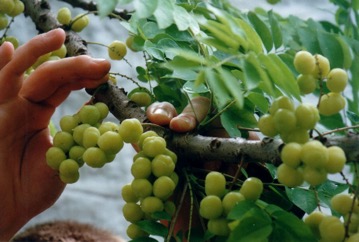
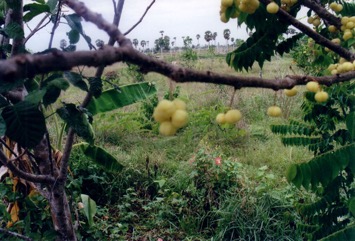
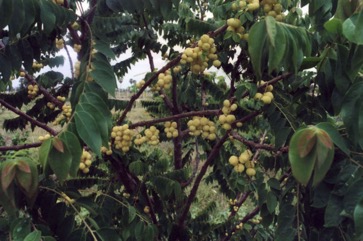
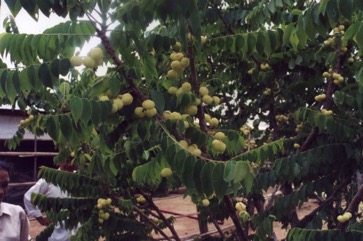
References
Ajesh, T. P., et al, 2012, Ethnobotanical Documentation of Wild Edible Fruits used by Muthuvan Tribes of Idukki, Kerala-India. International Journal of Pharma and Bio Sciences 3(3): 479-487
Altschul, S.V.R., 1973, Drugs and Foods from Little-known Plants. Notes in Harvard University Herbaria. Harvard Univ. Press. Massachusetts. no. 2089
Ambasta, S.P. (Ed.), 2000, The Useful Plants of India. CSIR India. p 123, 450
Anderson, E. F., 1993, Plants and people of the Golden Triangle. Dioscorides Press. p 218
Arora, R. K., 2014, Diversity in Underutilized Plant Species - An Asia-Pacific Perspective. Bioversity International. p 81
Ashton, M. S., et al 1997, A Field Guide to the Common Trees and Shrubs of Sri Lanka. WHT Publications Ltd. pdf p 208
Bajpai, O., et al, 2015, Tree species of the Himalayan Terai region of Uttar Pradesh, India: a checklist. Check List 11(4): 1718
Barrau, J., 1961 (1976 reprint), Subsistence Agriculture in Polynesia and Micronesia. Bernice P. Bishop Museum Bulletin 223, Honolulu, Hawaii, p 63 (As Cicca acida)
Barwick, M., 2004, Tropical and Subtropical Trees. A Worldwide Encyclopedic Guide. Thames and Hudson p 318
Bingtao, Li, et al, Euphorbiaceae. p 180
Bodkin, F., 1991, Encyclopedia Botanica. Cornstalk publishing, p 789
Brown, W.H., 1920, Wild Food Plants of the Philippines. Bureau of Forestry Bulletin No. 21 Manila. p 88 (As Cicca acida)
Burkill, H. M., 1985, The useful plants of west tropical Africa, Vol. 2. Kew.
Burkill, I. H., 1966,
Chakraborty, S. & Chaturbedi, H. P., 2014, Some Wild Edible Fruits of Tripura- A Survey. Indian Journal of Applied research. (4) 9
Chandrashekara, U. M., 2009, Tree species yielding edible fruit in the coffee-based homegardens of Kerala, India: their diversity, uses and management. Food Sec. 1:361-370 (As Cicca disticha)
Chin, H.F., & Yong, H.S., 1996, Malaysian Fruits in Colour. Tropical press, Kuala Lumpur p 44 (As Cicca acida)
Coronel, R.E., 1982, Fruit Collections in the Philippines. IBPGR Newsletter p 6 (As Cicca acida), 10 (As Phyllantus acidus)
Cruz-Garcia, G. S., & Price, L. L., 2011, Ethnobotanical investigation of 'wild' food plants used by rice farmers in Kalasin, Northeast Thailand. Journal of Ethnobiology and Ethnomedicine 7:33
Cundall, P., (ed.), 2004, Gardening Australia: flora: the gardener's bible. ABC Books. p 1034
Darley, J.J., 1993, Know and Enjoy Tropical Fruit. P & S Publishers. p 129
Das, S. and De, B., 2013, Evaluation of Angiotension I-Converting Enzyme (ACE) inhibitory potential of some underutilized indigenous fruits of West Bengal using an in vitro model. Fruits, Vol. 68:499-506 (As Cicca acida)
Engel, D.H., & Phummai, S., 2000, A Field Guide to Tropical Plants of Asia. Timber Press. p 110
Ethnobotany of Karbis. Chapter 4 in p 99
Facciola, S., 1998, Cornucopia 2: a Source Book of Edible Plants. Kampong Publications, p 100 (As Cicca acida)
Flora of Pakistan. www.eFloras.org
Food Composition Tables for use in East Asia FAO http://www.fao.org/infoods/directory No. 947
Hearne, D.A., & Rance, S.J., 1975, Trees for Darwin and Northern Australia. AGPS, Canberra p 94, Pl 26
Hedrick, U.P., 1919, (Ed.), Sturtevant's edible plants of the world. p 489 (As Phyllanthus acidissimus) (Also as Phyllanthus distichus)
Heywood, V.H., Brummitt, R.K., Culham, A., and Seberg, O., 2007, Flowering Plant Families of the World. Royal Botanical Gardens, Kew. p 251
Hibbert, M., 2002, The Aussie Plant Finder 2002, Florilegium. p 232
Jacquat, C., 1990, Plants from the Markets of Thailand. D.K. Book House p 76
Jahan, S. et al, 2011, Nutritional Profile of Some Tropical Fruits in Bangladesh: Specially Anti-Oxidant Vitamins and Minerals. Bangladesh Journal of Medical Science Vol. 10 No. 2 (As Cicca acida)
Jardin, C., 1970, List of Foods Used In Africa, FAO Nutrition Information Document Series No 2.p 154
John, L., & Stevenson, V., 1979, The Complete Book of Fruit. Angus & Robertson p 290
Kar, A., & Borthakur, S. K., 2008, Wild edible fruits of Karbi's of Karbi Anglong district of Assam, India, Pleione 2(2): 175-181 (As Cicca acida)
Kar, A., et al, 2013, Wild Edible Plant Resources used by the Mizos of Mizoram, India. Kathmandu University Journal of Science, Engineering and Technology. Vol. 9, No. 1, July, 2013, 106-126
Khan, D. & Shaukat, S.S., 2006, The Fruits of Pakistan: Diversity, Distribution, Trends of Production and Use. Int. J. Biol. Biotech., 3(3):463-499
Kiple, K.F. & Ornelas, K.C., (eds), 2000, The Cambridge World History of Food. CUP p 1827
Llamas, K.A., 2003, Tropical Flowering Plants. Timber Press. p 195
Lorenzi, H., Bacher, L., Lacerda, M. & Sartori, S., 2006, Brazilian Fruits & Cultivated Exotics. Sao Paulo, Instituto Plantarum de Estuados da Flora Ltda. p 474
Luczaj, L., et al, 2021, Wild food plants and fungi sold in the markets of Luang Prabang, Lao PDR. Journal of Ethnobiology and Ethnomedicine (2021) 17:6
Macmillan, H.F. (Revised Barlow, H.S., et al) 1991, Tropical Planting and Gardening. Sixth edition. Malayan Nature Society. Kuala Lumpur. p 305
Mahapatra, A. K., et al, 2012, Nutrient Analysis of some selected wild edible fruits of deciduous forests of India. Advance Journal of Food Science and Technology 4(1):15-21
Manandhar, N.P., 2002, Plants and People of Nepal. Timber Press. Portland, Oregon. p 359
Martin, F.W. & Ruberte, R.M., 1979, Edible Leaves of the Tropics. Antillian College Press, Mayaguez, Puerto Rico. p 55, 192
Martin, F. W., et al, 1987, Perennial Edible Fruits of the Tropics. USDA Handbook 642 p 27
Martin, M.A., 1971, Introduction L'Ethnobotanique du Cambodge. Centre National de la Recherche Scientifique. Paris.
McMakin, P.D., 2000, Flowering Plants of Thailand. A Field Guide. White Lotus. p 106
Medhi, P. & Borthakur, S. K., 2012, Phytoresources from North Cachur Hills of Assam -3: Edible plants sold at Hflong market. Indian Journal of Natural Products and Resources. 3(1) pp 84-109
Miguel, E., et al, 1989, A checklist of the cultivated plants of Cuba. Kulturpflanze 37. 1989, 211-357
Milow, P., et al, 2013, Malaysian species of plants with edible fruits or seeds and their evaluation. International Journal of Fruit Science. 14:1, 1-27 (Also as Cicca acida)
Monsalud, M.R., Tongacan, A.L., Lopez, F.R., & Lagrimas, M.Q., 1966, Edible Wild Plants in Philippine Forests. Philippine Journal of Science. p 467 (As Cicca acida)
Morton, J. F., 1987, Fruits of Warm Climates. Wipf & Stock Publishers p 211
Ochse, J.J. et al, 1931, Vegetables of the Dutch East Indies. Asher reprint. p 285
Owen, S., 1993, Indonesian Food and Cookery, INDIRA reprints. p 5 (As Cicca acida)
Pasha, M. K. & Uddin, S. B., 2019, Minor Edible Fruits of Bangladesh. Bangladesh J. Plant Taxon. 26(2): 299–313
Patiri, B. & Borah, A., 2007, Wild Edible Plants of Assam. Geethaki Publishers. p 128
Phon, P., 2000, Plants used in Cambodia. © Pauline Dy Phon, Phnom Penh, Cambodia. p 496
Plants of Haiti Smithsonian Institute http://botany.si.edu/antilles/West Indies
Polinag, M. A., 2003, Food from the Wilderness. Department of Environment and Natural Resources. Laguna. (As Cicca acida)
Prixar, S., et al, 2006, Species composition, distribution and management of trees in paddy fields in central Laos. p 24
PROSEA handbook Volume 13 Spices. p 279 and No. 2
Purseglove, J.W., 1968, Tropical Crops Dicotyledons, Longmans. p 139
Reis, S. V. and Lipp, F. L., 1982, New Plant Sources for Drugs and Foods from the New York Botanical Garden herbarium. Harvard. p 160
Royal Botanic Gardens, Kew (1999). Survey of Economic Plants for Arid and Semi-Arid Lands (SEPASAL) database. Published on the Internet; http://www.rbgkew.org.uk/ceb/sepasal/internet [Accessed 16th April 2011]
Sarma, H., et al, 2010, Updated Estimates of Wild Edible and Threatened Plants of Assam: A Meta-analysis. International Journal of Botany 6(4): 414-423
Segura, S., et al, 2018, The edible fruit species in Mexico. Genet Resour Crop Evol (2018) 65:1767–1793
Selvam, V., 2007, Trees and shrubs of the Maldives. RAP Publication No. 2007/12 p 128
Shah, G.L., 1984, Some economically important plant of Salsette Island near Bombay. J. Econ. Tax. Bot. Vol. 5 No. 4 pp 753-765 (As Cicca acida)
Sharma, B.B., 2005, Growing fruits and vegetables. Publications Division. Ministry of Information and broadcasting. India. p 7
Srichaiwong, P., et al, 2014, A Study of the Biodiversity of Natural Food Production to Support Community Upstream of Chi Basin, Thailand. Asian Social Science 10 (2):
Standley, P. C. & Record, S. J., 1936, The Forests and Flora of British Honduras. (Belize). p 222
Staples, G.W. and Herbst, D.R., 2005, A tropical Garden Flora. Bishop Museum Press, Honolulu, Hawaii. p 294
Sujanapal, P., & Sankaran, K. V., 2016, Common Plants of Maldives. FAO & Kerala FRI, p 204
Sukarya, D. G., (Ed.) 2013, 3,500 Plant Species of the Botanic Gardens of Indonesia. LIPI p 444
Swaminathan, M.S., and Kochnar, S.L., 2007, An Atlas of major Flowering Trees in India. Macmillan. p 238 (As Cicca acida)
Teron, R. & Borthakur, S. K., 2016, Edible Medicines: An Exploration of Medicinal Plants in Dietary Practices of Karbi Tribal Population of Assam, Northeast India. In Mondal, N. & Sen, J.(Ed.) Nutrition and Health among tribal populations of India. p 152
Thaman, R. R, 2016, The flora of Tuvalu. Atoll Research Bulletin No. 611. Smithsonian Institute p 84
Terra, G.J.A., 1973, Tropical Vegetables. Communication 54e Royal Tropical Institute, Amsterdam, p 67
U.S.D.A. Bur. Pl. Industr. Bull. 148:17. 1909
USDA, ARS, National Genetic Resources Program. Germplasm Resources Information Network - (GRIN). [Online Database] National Germplasm Resources Laboratory, Beltsville, Maryland. Available: www.ars-grin.gov/cgi-bin/npgs/html/econ.pl (10 April 2000)
van Roosmalen, M.G.M., 1985, Fruits of the Guianan Flora. Utrecht Univ. & Wageningen Univ. p 124
van Wyk, B., 2005, Food Plants of the World. An illustrated guide. Timber press. p 292
World Checklist of Useful Plant Species 2020. Royal Botanic Gardens, Kew
http://cookislands.bishopmuseum.org
www.nationalherbarium.nl/thaueuph/ Flora of Thailand.
www.worldagroforestrycentre.org/treedb/
Zawiah, N. & Othaman, H., 2012, 99 Spesies Buah di FRIM. Institut Penyelidikan Perhutanan Malaysia. p 194